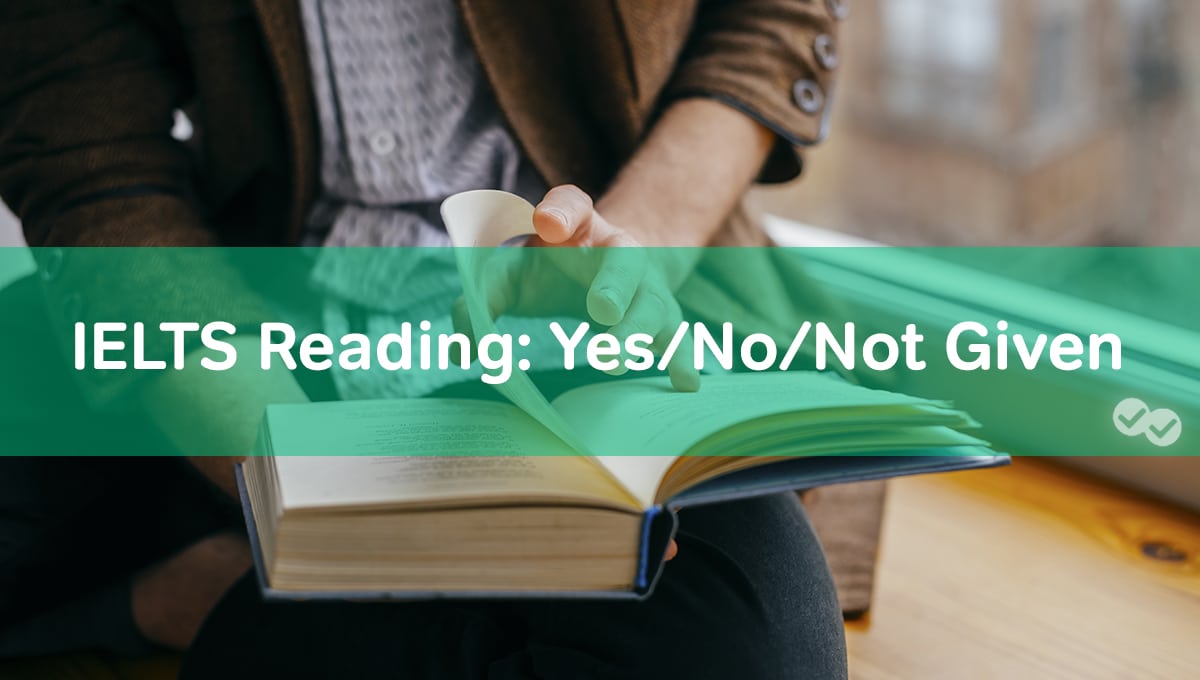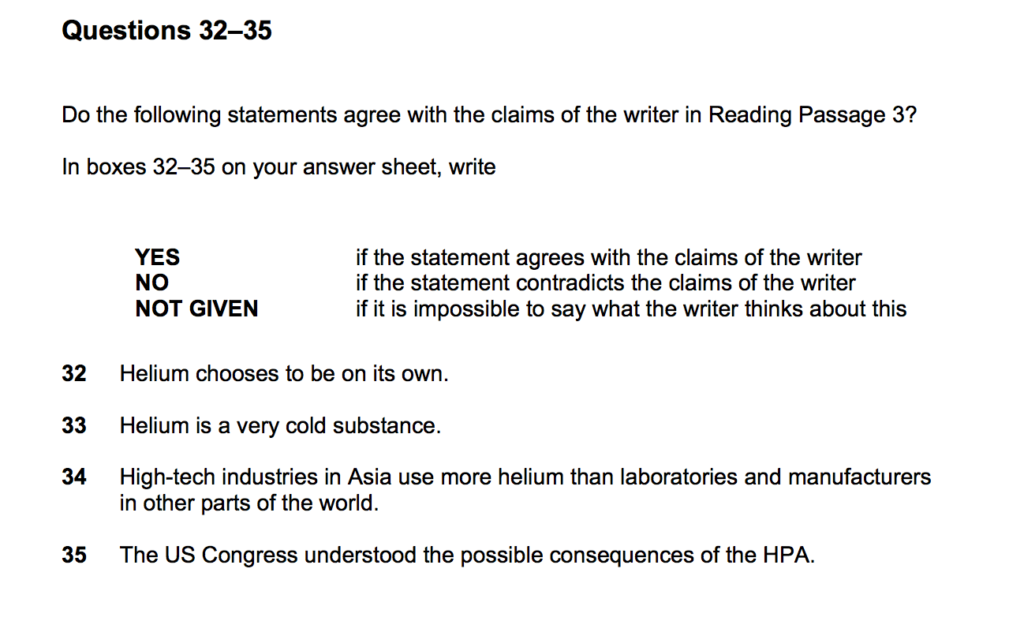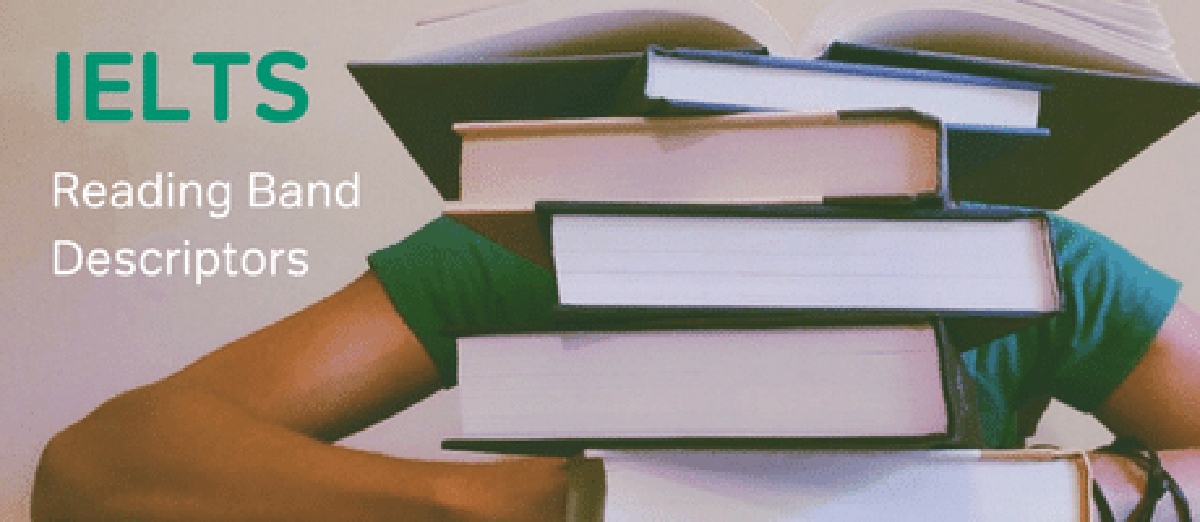As posted in our Complete Guide to IELTS Reading, the IELTS Reading module has 40 questions which you must answer in 60 minutes. These questions come in a variety of formats including:
- identifying writer’s views (yes/no/not given questions)
- multiple choice
- sentence completion
- fill gaps in a passage of written text or in a table
- match headings to written text to diagrams or charts
- give short answers to open questions
As the reading section can include between 1500 to 2500 words, learning techniques on how to answer each of these question types quickly will help ensure that you get top marks in this module.
Today, we are going to look at the identifying the writer’s views format, specifically the Yes/No/Not Given questions.

Yes/No/Not Given Question Format
The screenshot below is an example of a Yes/No/Not Given question taken from one of the British Council’s Academic Reading Practice Tests. These questions ask you if the given statement agrees or disagrees with what the writer said in the passage or if the statement was not mentioned in the passage. These types of questions are used to analyze the claims or opinions of the writer.
How to Tackle
These types of questions can be really difficult to answer. First, you must find the correlating information in the question statement to that of the words the reading passage. Then you must decide if the reading passage text of the writer agrees or disagrees with the question statement or if the information was not given at all. Even I find these types of questions hard, and I’m a native English speaker that used to score high marks on school exams! Hopefully by following these tips you can learn to tackle these types of questions with ease:
- Read the all of the question statements so that you know what information that you will need to look for in the reading passage. Note mentally or on a scrap piece of paper any proper nouns, nouns, or adjectives mentioned.
- Skim and scan the reading passages to find the words that are or relate to the proper nouns, nouns or adjectives in the question statements. Tackle the statement questions that have proper nouns in the statements first, as this information is easier to find through scanning. (You can learn how to skim and scan here.) Then move on to the other questions.
Example: In Question 35 above, you see the proper noun ‘US Congress’. You can quickly scan the text and find the following sentence: “Although intended to settle the original cost of the reserve by a U.S. Congress ignorant of its ramifications, the result of this fire sale is that global helium prices are so artificially deflated that few can be bothered recycling the substance or using it judiciously.” The bolded text includes both the proper noun US Congress and the information that will help you answer question 35. (Answer to Question 35: No. The question statement contradicts the statement of the writer.)
- Be aware that the words used in the statement questions will often be synonyms or have similar meanings to the relevant words in the reading passage, so don’t always look for the exact word.
Example: In Question 32 above, you have the statement. “Helium chooses to be on its own.” The Yes/No/Not Given answer for this statement can be found in the sentence “Helium is even cheerfully derided as a “loner” element since it does not adhere to other molecules like its cousin, hydrogen.” See that Helium is described as a ‘loner element’, which is another way of saying that Helium likes to be ‘on its own’. Therefore the answer to Q32 is Yes. This statement agrees with the writers.
- If you are finding it very difficult to find the information, there is a high probability that the information is not given. If you are pushed for time and need to make a guess then go for Not Given. If you have some more time you can again scan the reading passage for the section where the statement might appear and check to see if the statement is given.
Example: In Question 33 above you have the statement. ‘Helium is a cold substance.’ I skimmed the text for the passage that talked about what helium is. The only relevant passage was: ‘ Helium – an inert, odourless, monatomic element known to lay people as the substance that makes balloons float and voices squeak when inhaled – could be gone from this planet within a generation.’ I continued to scan for other adjectives that appeared around the noun Helium, but none mentioned anything about it being a cold substance. Therefore the answer to Q33 is Not Given.
- Finally, be careful to fully read the corresponding sentence once you find it, as often the reading passage can be very similar to the statement question so you might think that the answer is Yes, but if you read carefully, you might find that there is one additional word that makes the answer No.
Example: In a different IELTS Reading sample there was the question statement: “Thirty per cent of deaths in the United States are caused by smoking-related diseases.” The correlating reading passage was: “Smoking, it is believed, is responsible for 30 per cent of all deaths from cancer and clearly represents the most important preventable cause of cancer in countries like the United States today.” Note the bolded words. If you just scanned the passage you might have quickly answered this question as a Yes. However, the correct answer is ‘No’, as only 30 percent of all deaths from CANCER (not all types of deaths) are caused by smoking.
(A lot of students have asked about this question. See the EDITOR’S NOTE at the bottom of this post.)
Keeping some of these basic tips in mind when you come to the Yes/No/Not Given questions in the IELTS Reading module should help you get a few more points. Want even more? Check out the Magoosh IELTS prep!
EDITOR’S NOTE: Among IELTS students, there’s been a lot of debate about the IELTS Reading question immediately above. The official answer is “NO,” as seen on page 4 of this PDF from the official IELTS website.
However, many students feel the answer should actually be “NOT GIVEN.” This is because the passage doesn’t say anything one way or another about the percentage of all deaths caused by cigarettes. Based strictly on what is said in the passage, it is certainly not impossible that cigarettes cause both 30% of all cancer deaths and 30% of all deaths as a whole.
In spite of this, “NO” is still the best answer. If a piece of information has not been stated, you need to judge whether or not it is likely to be true. To judge whether or not a statement is likely to be true, you can use “common knowledge”– general things we all know about the world.
Think about it this way: If 30% of all deaths are caused by cigarettes, that would mean that about 1/3 of deaths happen due to cigarette use. If you consider the many ways people can die– old age, car accidents, war, fever, etc… it just doesn’t seem true that 1/3 of all deaths would be caused by cigarettes. It also would seem like a very strange coincidence if the percentage of cancer deaths caused by cigarettes is the exact same as the percentage of all deaths caused by cigarettes.
So while very strict logic within the passage says that it’s “not given” whether or not 30% of all deaths are caused by cigarettes, common sense and common knowledge would say that “NO,” it’s unlikely– and probably impossible– that such a figure would be correct. And in yes/no/not give questions on the IELTS, you will sometimes be expected to use both the information in the passage and common knowledge.
Additional Reading
There is a similar question type to this one: True/False/Not Given. To learn about the small but important differences between Yes/No and True/False, click here for our guide to T/F/NG in IELTS Reading. And be sure to check out our guide to all of the IELTS Reading question types.







Leave a Reply